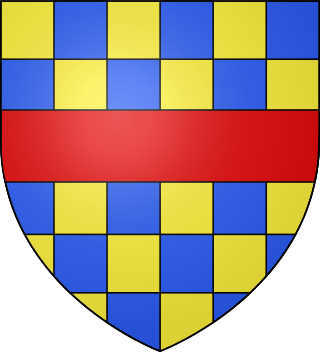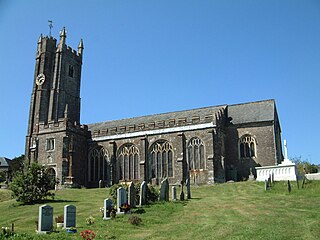
Richard was an English prince who was King of the Romans from 1257 until his death in 1272. He was the second son of John, King of England, and Isabella, Countess of Angoulême. Richard was nominal Count of Poitou from 1225 to 1243, and he also held the title Earl of Cornwall from 1225. He was one of the wealthiest men in Europe and joined the Barons' Crusade, where he achieved success as a negotiator for the release of prisoners and assisted with the building of the citadel in Ascalon.
The title of Earl of Cornwall was created several times in the Peerage of England before 1337, when it was superseded by the title Duke of Cornwall, which became attached to heirs-apparent to the throne.

William de Redvers, 5th Earl of Devon, of Tiverton Castle and Plympton Castle, both in Devon, was feudal baron of Plympton in Devon.

Robert de Clifford, 1st Baron de Clifford, of Appleby Castle, Westmorland, feudal baron of Appleby and feudal baron of Skipton in Yorkshire, was an English soldier who became 1st Lord Warden of the Marches, responsible for defending the English border with Scotland.

Trematon Castle is situated near Saltash in Cornwall, England, United Kingdom. It was the caput of the feudal barony of Trematon. It is similar in style to the later Restormel Castle, with a 12th-century keep. Trematon Castle overlooks Plymouth Sound and was built probably by Robert, Count of Mortain on the ruins of an earlier Roman fort: it is a motte-and-bailey castle and dates from soon after the Norman conquest. It occupies a sentinel position one and a half miles south-east of Trematon village.
Richard Fitz Turold was an eleventh-century Anglo-Norman landowner in Cornwall and Devon, mentioned in the Domesday Book. In the 13th century his estates formed part of the Feudal barony of Cardinham, Cornwall, and in 1166 as recorded in the Cartae Baronum his estates had been held as a separate fiefdom from Reginald, Earl of Cornwall.

Harberton is a village, civil parish and former manor 3 miles south west of Totnes, in the South Hams District of Devon, England. The parish includes the village of Harbertonford situated on the main A381 road. In the 2001 census the parish had a population of 1,285. The village is a major part of the electoral ward of Avon and Harbourne. At the 2011 census the ward population was 2,217.

Isabel de Forz was the eldest daughter of Baldwin de Redvers, 6th Earl of Devon (1217–1245). On the death of her brother Baldwin de Redvers, 7th Earl of Devon in 1262, without children, she inherited suo jure the earldom and also the feudal barony of Plympton in Devon, and the Lordship of the Isle of Wight. After the early death of her husband and her brother, before she was thirty years old, she inherited their estates and became one of the richest women in England, living mainly in Carisbrooke Castle on the Isle of Wight, which she held from the king as tenant-in-chief.
Modbury Priory was a Benedictine priory in the parish of Modbury, Devon, England, established before 1129 which was one of the longest surviving alien priories in England, most of which were suppressed in 1414. It was located close to the present parish church of St George in the town of Modbury, but its exact location is unclear.

From AD 1066, the feudal barony of Barnstaple was a large feudal barony with its caput at the town of Barnstaple in north Devon, England. It was one of eight feudal baronies in Devonshire which existed in the Middle Ages. In 1236 it comprised 56 knight's fees or individual member manors. The feudal service owed for half the barony in 1274 was the provision to the royal army of two knights or four sergeants for forty days per annum, later commuted to scutage.

The feudal barony of Okehampton was a very large feudal barony, the largest mediaeval fiefdom in the county of Devon, England, whose caput was Okehampton Castle and manor. It was one of eight feudal baronies in Devonshire which existed during the mediaeval era.

Launceston was one of three Feudal baronies in Cornwall which existed in the mediaeval era. Its caput was at Launceston Castle.
The Feudal barony of Cardinham is one of the three feudal baronies in Cornwall which existed during the medieval era. Its caput was at Cardinham Castle, Cornwall. The Barony was held in recent times by the Vivian family, the last being Nicholas Vivian, 6th Baron Vivian. Brigadier Nicholas Crespigny Laurence Vivian, 6th Baron Vivian, conveyed the title to John Anthony Vincent of Edifici Maxim's, Carrer General, Arsinal, Principat Andora, in 1995. Mr. Vincent was a member of the Manorial Society of Great Britain and died in Douglas, Isle of Man, on 31 March 2018. The Barony was then conveyed after the probate of his estate to an American citizen on 25 May 2019.

The feudal barony of Plympton was a large feudal barony in the county of Devon, England, whose caput was Plympton Castle and manor, Plympton. It was one of eight feudal baronies in Devonshire which existed during the medieval era. It included the so-called Honour of Christchurch in Hampshire, which was not however technically a barony. The de Redvers family, first holders of the barony, were also Lords of the Isle of Wight, which lordship was not inherited by the Courtenays, as was the barony of Plympton, as it had been sold to the king by the last in the line Isabel de Redvers, 8th Countess of Devon (1237–1293).
The feudal barony of Curry Mallet was an English feudal barony with its caput at Curry Mallet Castle in Somerset, about 7 miles east of Taunton.

The feudal barony of Hatch Beauchamp or honour of Hatch Beauchamp was an English feudal barony with its caput at the manor of Hatch Beauchamp in Somerset. The site of the mediaeval manor house, to the immediate south of the ancient parish church of St John the Baptist, is today occupied by Hatch Court, a grade I listed mansion built in about 1755 in the Palladian style.

Orcheton is an historic estate in the parish of Modbury in Devon. The present house, known as Great Orcheton Farm is situated 1+1⁄2 miles south-west of Modbury Church.

Fardel is a historic manor in the parish of Cornwood, in the South Hams district of Devon. It was successively the seat of the Raleigh and Hele families. The surviving Grade I listed medieval manor house is situated about half-way between Cornwood and Ivybridge, just outside the Dartmoor National Park on its south-western border.

Hareston is an historic estate in the parish of Brixton, about three miles from Plymouth in Devon. The mansion house built during the reign of King Henry VII (1485-1509) burned down partially in an accidental fire at the beginning of the 18th century, and in 1822 the surviving part, the Hall and Chapel, was being used as a farmhouse. It was described by Candida Lycett Green in her 1991 book The Perfect English Country House as: "The most forgotten Manor House Farm In England, untouched for hundreds of years, sits safely, impossible to find, down miles of private sunken lanes which in the spring brim with Campion, Bluebells, Purple Orchids, Primroses, Violets, Speedwell and Stitchwort. Wooded hills rise behind this, the quintessence of an ancient English Manor House".

Spridleston is an historic manor in the parish of Brixton in Devon, England, long a seat of a branch of the prominent and widespread Fortescue family. The ancient manor house does not survive, but it is believed to have occupied the site of the present Spriddlestone Barton, a small Georgian stuccoed house a few hundred yards from the larger Spriddlestone House, also a Georgian stuccoed house, both centred on the hamlet of Spriddlestone and near Higher Spriddlestone Farm.
















